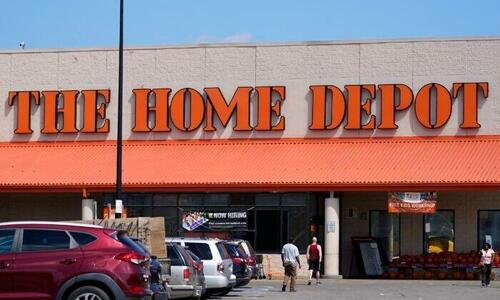
Authored by Michael Wilkerson via The Epoch Times,
If anyone still believes that the U.S. economy is doing just fine, they should take a closer look at what is happening to the retailers that depend upon the faithful American consumer to “shop, shop, shop” to keep the economy afloat. American consumers are rapidly running out of firepower, and now, so too are the retailers that depend on them.
Consumer Spending Cuts
American consumers, increasingly overextended on credit card debt, and having depleted their pandemic-accumulated savings, have started to close their wallets to all but essential, non-discretionary purchases such as food and fuel. The portion of surveyed Americans who state a positive intent to purchase big ticket items such as a home, an automobile, or a major appliance has fallen substantially since May. The bigger the ticket, the steeper the drop off. For example, the percentage of respondents stating intent to purchase a home has fallen to the lowest level in the post-lockdowns era.
This is in part a consequence of inflation and the rising interest rates used to combat it. With the cost of food, energy, and shelter all up well over 20 percent from three years ago, and real wages lagging behind, Americans are having to make difficult tradeoffs. With mortgages some 4 percent higher, yet housing stock more expensive than ever, new home purchases are out of the question for many. But the pain extends further. Almost every discretionary spending category is flat or in decline as consumers feel the pinch of lost purchasing power. Nowhere is this more evident than in the performance of the U.S. retail chains.
Impact on Major Retailers
For the big box retailers, the writing has been on the wall for a while. For home improvement retailers such as Home Depot and Lowe’s, companywide same-store comparable sales, which compares the sales of a store open for at least a year against the previous period, have been in decline for six quarters. The same trends can be seen in the consumer electronics space, where Best Buy has posted negative same-store sales, sometimes in the double digits, for 10 consecutive quarters. Venerable Target, a traditional favorite of middle-class consumers, has also posted negative comps for a year now.
The discount stores are faring only slightly better. Dollar General, a pillar of support for low-income families, is treading water with flat sales, while Walmart has seen its comparable store sales fall from nearly 9 percent two years ago to less than 4 percent in its most recent quarter. Costco is following the same trend. For nearly all of the retailers, even those managing to grow revenue, profit margins are compressing as they are forced to discount more heavily to attract the otherwise beleaguered shopper.
For the second tier of retailers, especially those in the home products space, the pressure is too much. Furniture chain Conn’s has filed for bankruptcy and is liquidating its more than 70 stores after 134 years in operation. Big Lots, the off-price home goods retailer, is closing 150 stores and trying to raise rescue capital to avoid bankruptcy itself.
Conn’s and Big Lots aren’t alone. Over the past year, business bankruptcy filings are up 40.3 percent, and have now reached a number not seen since the second quarter of 2020, at the peak of lockdowns. American households are following along, with total bankruptcy filings up 16.2 percent in the past year, including 132,710 new filings in the second quarter of 2024 alone.
The global iconic brands are not immune to the consumer downturn. Starbucks just announced a decline in comp store sales, number of orders, revenue, and operating profit. Starbucks’s shares are down 25 percent over the past 12 months, and activist shareholders are pushing hard for change. The newly ensconced CEO, charged with a major restructuring of the business, quipped, “We are focused on what we can control in a consumer environment that can be best described as complex.” Complex it is.
Not even value mainstay McDonald’s is safe in this environment. The fast-food retailer and consumer bellwether just announced second-quarter earnings. The company reported that comparable store sales declined 1 percent, as did revenue, which marked the first revenue decline since lockdowns. McDonald’s CEO commented that consumers are “dropping out of the market, eating at home and finding other ways to economize, cutting down on trips.” He noted that, regarding their newly launched $5 value meal, “it’s just not enough to offset the pressure that we’re seeing on that low-income consumer.”
There is perhaps a silver lining in all of this. The advanced estimate for second-quarter GDP recently came in at 2.8 percent (compared with an anemic 1.4 percent for the first quarter), indicating that the economy may be picking up some steam. The national GDP number masks the fact that there are faster-growing regions in the country, such as in the South and Mountain West, where economies are relatively thriving, and where job opportunities are more plentiful than in the Northeast, West Coast, and Midwest. Americans’ mobility and willingness to migrate have always been a positive factor toward moving the country out of recession.
In the meantime, both households and businesses are being forced to reconsider what are their most important priorities and to allocate scarce capital accordingly. Inefficient firms, which benefited for too long from zero interest rates, will either fix their business models or fail. There may be more pain to come in the short term, but the American economy has always proven resilient, and continues to have the natural, human, and technological resources needed to start growing again.
Authored by Michael Wilkerson via The Epoch Times,
If anyone still believes that the U.S. economy is doing just fine, they should take a closer look at what is happening to the retailers that depend upon the faithful American consumer to “shop, shop, shop” to keep the economy afloat. American consumers are rapidly running out of firepower, and now, so too are the retailers that depend on them.
Consumer Spending Cuts
American consumers, increasingly overextended on credit card debt, and having depleted their pandemic-accumulated savings, have started to close their wallets to all but essential, non-discretionary purchases such as food and fuel. The portion of surveyed Americans who state a positive intent to purchase big ticket items such as a home, an automobile, or a major appliance has fallen substantially since May. The bigger the ticket, the steeper the drop off. For example, the percentage of respondents stating intent to purchase a home has fallen to the lowest level in the post-lockdowns era.
This is in part a consequence of inflation and the rising interest rates used to combat it. With the cost of food, energy, and shelter all up well over 20 percent from three years ago, and real wages lagging behind, Americans are having to make difficult tradeoffs. With mortgages some 4 percent higher, yet housing stock more expensive than ever, new home purchases are out of the question for many. But the pain extends further. Almost every discretionary spending category is flat or in decline as consumers feel the pinch of lost purchasing power. Nowhere is this more evident than in the performance of the U.S. retail chains.
Impact on Major Retailers
For the big box retailers, the writing has been on the wall for a while. For home improvement retailers such as Home Depot and Lowe’s, companywide same-store comparable sales, which compares the sales of a store open for at least a year against the previous period, have been in decline for six quarters. The same trends can be seen in the consumer electronics space, where Best Buy has posted negative same-store sales, sometimes in the double digits, for 10 consecutive quarters. Venerable Target, a traditional favorite of middle-class consumers, has also posted negative comps for a year now.
The discount stores are faring only slightly better. Dollar General, a pillar of support for low-income families, is treading water with flat sales, while Walmart has seen its comparable store sales fall from nearly 9 percent two years ago to less than 4 percent in its most recent quarter. Costco is following the same trend. For nearly all of the retailers, even those managing to grow revenue, profit margins are compressing as they are forced to discount more heavily to attract the otherwise beleaguered shopper.
For the second tier of retailers, especially those in the home products space, the pressure is too much. Furniture chain Conn’s has filed for bankruptcy and is liquidating its more than 70 stores after 134 years in operation. Big Lots, the off-price home goods retailer, is closing 150 stores and trying to raise rescue capital to avoid bankruptcy itself.
Conn’s and Big Lots aren’t alone. Over the past year, business bankruptcy filings are up 40.3 percent, and have now reached a number not seen since the second quarter of 2020, at the peak of lockdowns. American households are following along, with total bankruptcy filings up 16.2 percent in the past year, including 132,710 new filings in the second quarter of 2024 alone.
The global iconic brands are not immune to the consumer downturn. Starbucks just announced a decline in comp store sales, number of orders, revenue, and operating profit. Starbucks’s shares are down 25 percent over the past 12 months, and activist shareholders are pushing hard for change. The newly ensconced CEO, charged with a major restructuring of the business, quipped, “We are focused on what we can control in a consumer environment that can be best described as complex.” Complex it is.
Not even value mainstay McDonald’s is safe in this environment. The fast-food retailer and consumer bellwether just announced second-quarter earnings. The company reported that comparable store sales declined 1 percent, as did revenue, which marked the first revenue decline since lockdowns. McDonald’s CEO commented that consumers are “dropping out of the market, eating at home and finding other ways to economize, cutting down on trips.” He noted that, regarding their newly launched $5 value meal, “it’s just not enough to offset the pressure that we’re seeing on that low-income consumer.”
There is perhaps a silver lining in all of this. The advanced estimate for second-quarter GDP recently came in at 2.8 percent (compared with an anemic 1.4 percent for the first quarter), indicating that the economy may be picking up some steam. The national GDP number masks the fact that there are faster-growing regions in the country, such as in the South and Mountain West, where economies are relatively thriving, and where job opportunities are more plentiful than in the Northeast, West Coast, and Midwest. Americans’ mobility and willingness to migrate have always been a positive factor toward moving the country out of recession.
In the meantime, both households and businesses are being forced to reconsider what are their most important priorities and to allocate scarce capital accordingly. Inefficient firms, which benefited for too long from zero interest rates, will either fix their business models or fail. There may be more pain to come in the short term, but the American economy has always proven resilient, and continues to have the natural, human, and technological resources needed to start growing again.
Loading…






